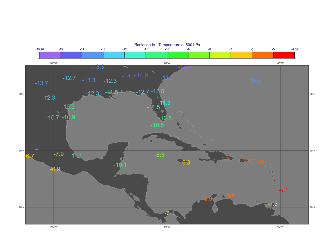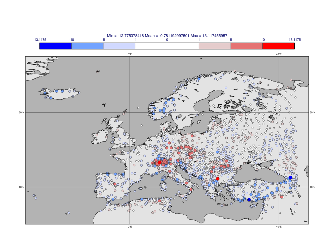What is Geopoints?Geopoints is Metview's own format for storing irregularly distributed geographical data (typically observations). A geopoints file is an ASCII file containing a header section and a data section consisting of several columns, so it can be regarded as specialised CSV (Comma Separated Values) file. The full specification of the format can be found on Metview's Geopoints overview page. The Geopoints iconGeopoints files are represented by this icon in the user interface: 
Examining Geopoints contentsThe contents of a Geopoints file can be inspected with the Geopoints Examiner, which can be started up from the user interface (right-click examine on the icon). 
Visualisation on mapsGeopoints can be directly visualised in Metview on a map view. In the user interface just right-click visualise on the icon to get a plot with the default settings. These plots can be further customised with Symbol Plotting (scalar values) and Wind Plotting (vector values) icons.   Visualisation with Table VisualiserSince Geopoints is a CSV data format it can be also visualised with the Table Visualiser icon, which can handle generic CSV data files. Geopoints and BUFRThe typical way to handle BUFR data in Metview is to filter it into a Geopoints file using the Observation Filter and Bufr Picker icons. The resulting data is then visualised or further processed with Metview's rich Geopoints API.  Operators between GRIB and GeopointsIt is a typical scenario in Metview that we have forecast data in GRIB format and some corresponding observations in Geopoints (probably filtered from BUFR) and we want to compute the difference between them. Using Metview's script interface it can be done in a single line like this (supposing g is a fieldset while gpt is a geopoints object): | Code Block |
|---|
| gpt_diff = g - gpt |
For a full fledged example just click the image below. 
Conversion between Geopoints and GRIBA GRIB field can be directly exported into Geopoints using the Grib To Geopoints icon. The inverse task is also possible with the Geopoints To Grib icon, which offers various interpolation techniques to compute the grid point values from the values available at scattered locations. Combining multiple GeopointsMultiple Geopoints files can be comgined Script language supportMetview provides support for Geopoints from its Macro and Python interfaces. This includes (on top of the icon functions): - metadata access
- value access and modification
- sorting, filtering and subsampling,
- distance computation
- mathematical functions and high level geopoints arithmetic
The list of available functions for Geopoints can be found on the Geopoints Functions page. |